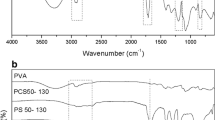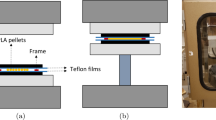Abstract
A previous investigation (J. Mater. Sci. 22 (1987) 1707) has shown that nylon polymers are susceptible to stress cracking by aqueous calcium chloride at slightly elevated temperatures (50° C). In the present study, the nylon-salt interactions were investigated using thin films of both nylon 6 and nylon 6,6. Chemical, thermal, infrared and dynamic mechanical analyses were performed along with tensile property determinations. Weight gain measurements indicated that above 50° C large increases in sorption occurred for films immersed in either aqueous calcium, lithium, or magnesium chlorides. Both salt ions and water were absorbed at the elevated temperature. In contrast to these results, the data for sodium chloride indicated that only water was absorbed at all temperatures. The sorption process was shown to be physically reversible since the absorbed salt could be removed by immersion in pure water. Moreover the sorption of the salt solution at 100° C did not produce chemical degradation or significant crystallization of the nylons. At higher temperatures the absorbed salt did modify the recrystallization behaviour and increase theT g of the nylons. Significant reductions in tensile modulus were observed for nylon films equilibrated in the salt solutions and tensile elongations at rupture were increased. The effect of increasing temperature and salt type on the sorption process parallels the previously observed stress-cracking activity of the aqueous salt solutions. It is therefore suggested that a plasticization-like mechanism is responsible for the salt-induced crazing of the crystalline nylons.
Similar content being viewed by others
References
C. D. Weiske,Kunstoffe 54 (1964) 626.
P. Dunn andG. F. Sansom,J. Appl. Polym. Sci. 13 (1969) 1641.
M. G. Wyzgoski, in “Macromolecular Solutions: Solvent Property Relationships in Polymers” edited by R. B. Seymour and G. A. Stahl (Pergamon, New York, 1982) p. 41.
M. G. Wyzgoski andG. E. Novak,J. Mater. Sci. 22 (1987) 1707.
J. Brandup andE. H. Immergut (eds). “Polymer 14Handbook” (2nd Edn) (Wiley, New York, 1975) p. III-5.
M. G. Wyzgoski andG. E. Novak, in preparation.
D. O. Hummel, “Infrared Spectra of Polymers” (Interscience, New York, 1966) p. 61.
C. G. Cannon,Spectrochim. Acta. 16 (1960) 302.
D. S. Trifan andJ. F. Terenzi,J. Polym. Sci. 28 (1958) 443.
P. Dunn andG. F. Sansom,ibid. 13 (1969) 1657.
H. Kim andP. J. Harget,J. Appl. Phys. 50 (1979) 6072.
M. I. Koran, “Nylon Plastics” (Wiley, New York, 1973) p. 329.
N. G. McCrum, B. E. Read andG. Williams, “Anelastic and Dielectric Effects in Polymeric Solids” (Wiley, New York, 1967) p. 480.
J. G. Williams andG. P. Marshall,Proc. R. Soc. A342 (1975) 55.
E. J. Kramer andR. A. Bugeck,J. Polym. Sci. 16 (1978) 1195.
Author information
Authors and Affiliations
Rights and permissions
About this article
Cite this article
Wyzgoski, M.G., Novak, G.E. Stress cracking of nylon polymers in aqueous salt solutions. J Mater Sci 22, 1715–1723 (1987). https://doi.org/10.1007/BF01132397
Received:
Accepted:
Issue Date:
DOI: https://doi.org/10.1007/BF01132397




